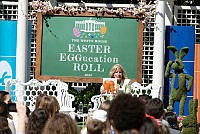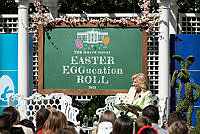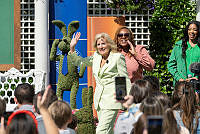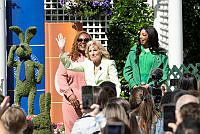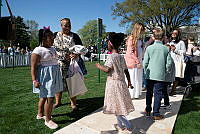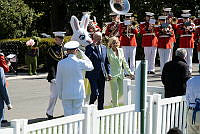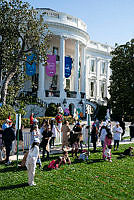Easter Egg Roll: Games, Old and New
Copyright © White House Historical Association. All rights reserved under international copyright conventions. No part of this article may be reproduced or utilized in any form or by any means, electronic or mechanical, including photocopying, recording, or by any information storage and retrieval system, without permission in writing from the publisher. Requests for reprint permissions should be addressed to books@whha.org

In this photograph taken on April 1, 1929 by Herbert E. French of the National Photo Company, a group of children scramble for eggs during the White House Easter Egg Roll. Dating back to 1878, the Easter Egg Roll is a cherished springtime tradition in Washington, D.C., with children and their families gathering to enjoy festivities on the South Lawn. This photograph is from the Herbert E. French Collection at the Library of Congress, which captured life in Washington, D.C., from the Wilson to the Hoover administrations.
Library of CongressThe primary Easter Monday entertainment at the White House has always involved egg rolling. Participants roll dyed, hard-boiled eggs across the grass to see whose will go the furthest before cracking. Other egg sports enjoyed in the early years were egg ball, toss and catch, egg croquet and egg picking—a contest where eggs are pecked together until they crack. After a few days, the odor of all the eggs broken in these free-form games "could be smelled three square miles away."

This is a photograph taken April 1, 2002, by White House photographer Eric Draper. It shows children using plastic spoons to roll hard boiled eggs to the finish line at the annual White House Easter Egg Roll. Dating back to 1878, the Easter Egg Roll is a cherished springtime tradition in Washington, D.C., with children and their families gathering to enjoy festivities on the South Lawn.
George W. Bush Presidential Library and Museum/NARAIn 1929, First Lady Lou Hoover hoped to end the rotten egg stench by introducing folk dancing. Her successor, First Lady Eleanor Roosevelt, thought it better to impose a sense of structure to egg-based activities. First Lady Pat Nixon's staff arranged the only Easter egg hunt with actual eggs. Unfound eggs quickly reminded people of why First Lady Lou Hoover had favored folk dancing. In 1974, the Nixons hosted the egg roll races, an event which has become an Easter Monday favorite.























